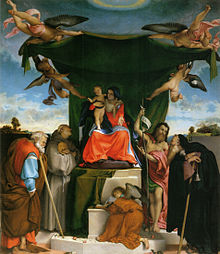
Lorenzo Lotto was an Italian painter, draughtsman, and illustrator, traditionally placed in the Venetian school, though much of his career was spent in other north Italian cities. He painted mainly altarpieces, religious subjects and portraits. He was active during the High Renaissance and the first half of the Mannerist period, but his work maintained a generally similar High Renaissance style throughout his career, although his nervous and eccentric posings and distortions represented a transitional stage to the Florentine and Roman Mannerists.

Giovanni Battista Moroni was an Italian painter of the Mannerism. He also is called Giambattista Moroni. Best known for his elegantly realistic portraits of the local nobility and clergy, he is considered one of the great portrait painters of the Cinquecento.

Alessandro Bonvicino, more commonly known as Moretto, or in Italian Il Moretto da Brescia, was an Italian Renaissance painter from Brescia, where he also mostly worked. His dated works span the period from 1524 to 1554, but he was already described as a master in 1516. He was mainly a painter of altarpieces that tend towards sedateness, mostly for churches in and around Brescia, but also in Bergamo, Milan, Verona, and Asola; many remain in the churches they were painted for. The majority of these are on canvas, but a considerable number, including some large pieces, are created on wood panels. There are only a few surviving drawings from the artist.

Vincenzo Foppa was an Italian painter from the Renaissance period. While few of his works survive, he was an esteemed and influential painter during his time and is considered the preeminent leader of the Early Lombard School. He spent his career working for the Sforza family, Dukes of Milan, in Pavia, as well as various other patrons throughout Lombardy and Liguria. He lived and worked in his native Brescia during his later years.

Giovanni Girolamo Savoldo, also called Girolamo da Brescia, was an Italian High Renaissance painter active mostly in Venice, although he also worked in other cities in northern Italy. He is noted for his subtle use of color and chiaroscuro, and for the sober realism of his works, which are mostly religious subjects, with a few portraits. His portraits are given interest by their accessories or settings; "some even look like extracts from larger narratives".

Girolamo Romani, known as Romanino, was an Italian High Renaissance painter active in the Veneto and Lombardy, near Brescia. His long career brought forth several different styles.
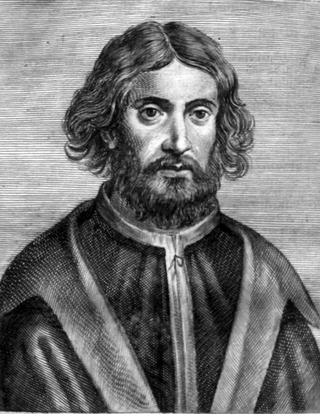
Palma Vecchio, born Jacopo Palma, also known as Jacopo Negretti, was a Venetian painter of the Italian High Renaissance. He is called Palma Vecchio in English and Palma il Vecchio in Italian to distinguish him from Palma il Giovane, his great-nephew, who was also a painter.
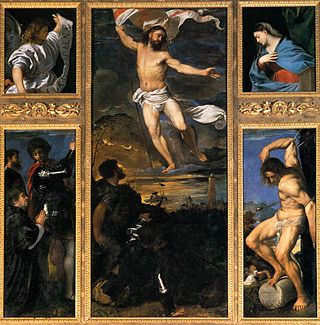
The Averoldi Polyptych, also known as the Averoldi Altarpiece, is a painting by the Italian Renaissance painter Titian, dating to 1520–1522, in the basilica church of Santi Nazaro e Celso in Brescia, northern Italy.
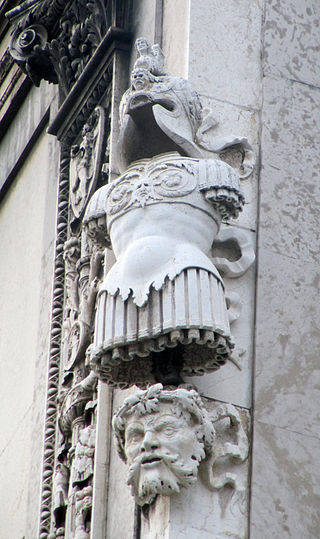
Gasparo Cairano, also known as Gasparo da Cairano, de Cayrano, da Milano, Coirano, and other variations, was an Italian Renaissance sculptor.
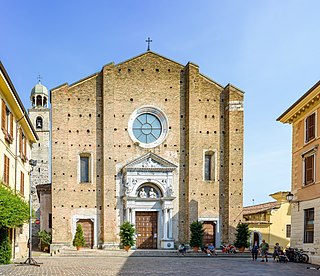
Santa Maria Annunziata is the main religious building (duomo) of the town of Salò, Italy.
Antonio della Porta, better known as Tamagnino was an Italian sculptor of the Renaissance.
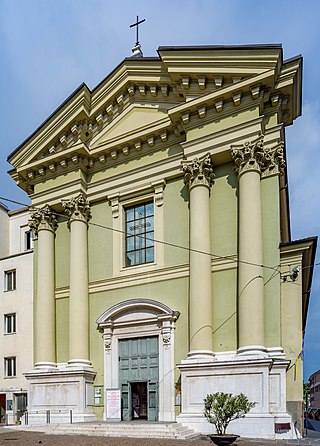
Sant'Alessandro is a Baroque style, Roman Catholic parish church located on Via Moretto, 73/A in Brescia, region of Lombardy, Italy.

Brescia is a city and comune in the region of Lombardy, in Italy. It is situated at the foot of the Alps, a few kilometers from the lakes Garda and Iseo. With a population of more than 200,000, it is the second largest city in Lombardy and the fourth largest in northwest Italy. The urban area of Brescia extends beyond the administrative city limits and has a population of 672,822, while over 1.5 million people live in its metropolitan area. The city is the administrative capital of the Province of Brescia, one of the largest in Italy, with over 1,200,000 inhabitants.

The Diocesan museum of Brescia is a museum in Italy dedicated to the artistic patrimony of the Diocese of Brescia, and is located in the greater cloister of the Monastery of Saint Joseph in via Gasparo Salò, a short distance from the Piazza della Loggia.
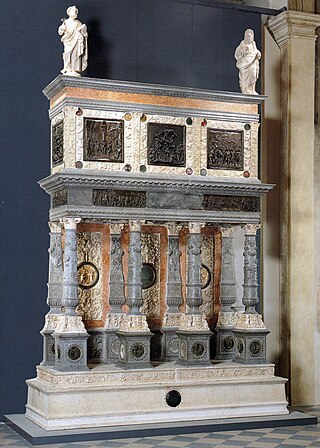
Bernardino delle Croci was an Italian goldsmith and sculptor of the Brescian Renaissance. He was the founder of the Delle Croci family of important goldsmiths and sculptors, known for their specialism in processional crosses, reliquaries and altars.

The Assassination of Saint Peter Martyr or The Martyrdom of Saint Peter of Verona is a 1530–1535 oil on canvas painting by Moretto da Brescia, now in the Sala dell'Esedra in the Pinacoteca Ambrosiana in Milan.

Count Guglielmo Lochis was an Italian nobleman, politician, art collector and art connoisseur.
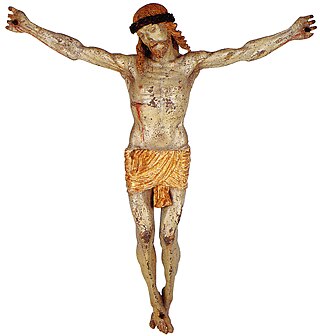
Maffeo Olivieri was an Italian sculptor and wood carver. Often associated with his younger brother Andrea, he was active in Lombardy, Venice and Trentino. He was known for his bronze, wood and marble creations, and considered the premier sculptor in early sixteenth century Brescia.

The Altar of San Girolamo is a sculptural complex in marble, around 780×450×80cm in dimension, designed and constructed by Gasparo Cairano and Antonio Medaglia, and situated within the Church of St Francis of Assisi in Brescia, Italy. Dated between 1506–1510, it is located in the first chapel on the right side of the nave.

The Italian Renaissance in Lombardy, in the Duchy of Milan in the mid-15th century, started in the International Lombard Gothic period and gave way to Lombard humanism with the passage of power between the Visconti and Sforza families. In the second half of the 15th century the Lombard artistic scene developed without disruption, with influences gradually linked to Florentine, Ferrarese, and Paduan styles. With the arrival of Bramante (1479) and Leonardo da Vinci (1482), Milan reached absolute artistic heights in the Italian and European panorama, while still demonstrating the possibilities of coexistence between the artistic avant-garde and the Gothic substratum.

